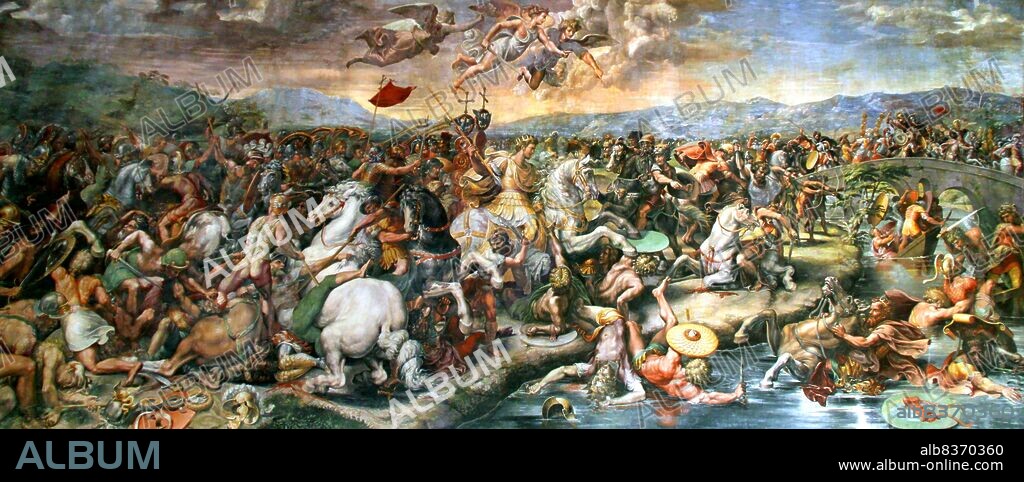alb8370360
Italy: 'The Battle of the Milvian Bridge', fresco painting by Giulio Romano (1499-1546),16th century, Vatican Museums, Vatican City

|
Add to another lightbox |
|
Add to another lightbox |



Title:
Italy: 'The Battle of the Milvian Bridge', fresco painting by Giulio Romano (1499-1546),16th century, Vatican Museums, Vatican City
Caption:
Constantine I (272-337), also known as Constantine the Great and Saint Constantine, was the son of Emperor Constantius. His father sent him east to serve under Emperors Diocletian and Galerius, spending some time in the court of the latter. After his father died in 306 CE, Constantine was proclaimed his successor and emperor by his army at Eboracum (York).
. He at first remained officially neutral in the efforts of Emperor Galerius to defeat the usurper Maxentius, but after Galerius' death, Constantine was dragged into the conflict. He eventually defeated Maxentius in 312 CE, and then fought against his erstwhile ally, Emperor Licinius, for sole control of both western and eastern portions of the Roman Empire. Licinius was defeated in 324 CE, and Constantine became emperor of a united empire.
. Constantine enacted many reforms strengthening the empire, ending the tetrarchy system and restructuring government. He became the first emperor to claim conversion to Christianity, and he called the First Council of Nicaea in 325 CE, overseeing the profession of the Nicene Creed. He renamed Byzantium to Constantinople after himself, which would become the new capital. He died in 337 CE.
. He at first remained officially neutral in the efforts of Emperor Galerius to defeat the usurper Maxentius, but after Galerius' death, Constantine was dragged into the conflict. He eventually defeated Maxentius in 312 CE, and then fought against his erstwhile ally, Emperor Licinius, for sole control of both western and eastern portions of the Roman Empire. Licinius was defeated in 324 CE, and Constantine became emperor of a united empire.
. Constantine enacted many reforms strengthening the empire, ending the tetrarchy system and restructuring government. He became the first emperor to claim conversion to Christianity, and he called the First Council of Nicaea in 325 CE, overseeing the profession of the Nicene Creed. He renamed Byzantium to Constantinople after himself, which would become the new capital. He died in 337 CE.
Credit:
Album / Universal Images Group / Pictures From History
Releases:
Model: No - Property: No
Rights questions?
Rights questions?
Image size:
5100 x 2137 px | 31.2 MB
Print size:
43.2 x 18.1 cm | 17.0 x 7.1 in (300 dpi)
Keywords:
16 16TH XVI XVITH SIXTEENTH CENTURY • 16 CENTURY • 16TH CENTURY • 16TH • ART • ARTS • BATTLE OF THE MILVIAN BRIDGE, THE • CAESAR • CESAR • CONSTANINIAN DYNASTY • CONSTANTINE THE GREAT • CONSTANTINE • CONSTANTINIAN • DYNASTY • EMPERADOR OF ROME • EMPEROR • EMPERORS, ROMAN • EMPIRE • FLAVIUS VALERIUS AURELIUS CONSTANTINUS AUGUSTUS • FRESCO • GIULIO PIPPI • ITALIA • ITALIAN • ITALY • KAISER • LEGEND • MARCUS AURELIUS VALERIUS MAXENTIUS AUGUSTUS • MAXENTIUS • MILVIAN BRIDGE • MONARCH • MONARCHY • PAINT • PAINTING • ROMAN EMPEROR • ROMAN EMPIRE • ROMAN • ROMANO • ROMANO, GIULIO • ROME • RULER • SAINT CONSTANTINE • VATICAN
 Pinterest
Pinterest Twitter
Twitter Facebook
Facebook Copy link
Copy link Email
Email

